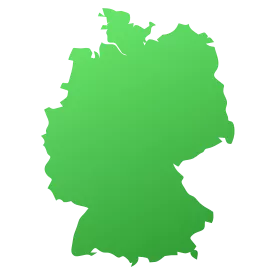Germany


Discover Germany
Fun Foods
Bratwurst, Schnitzel , Brezeln, Black Forest cake, and German Chocolate
Imagine someone built a wall through your neighborhood. Your best friend lives on the other side and you can't see them for 28 years. That actually happened in Germany.
Germany sits right in the middle of Europe. It's where fairy tales come from and where people take bread extremely seriously.
For most of history, Germany wasn't one country. It was dozens of tiny kingdoms fighting over who had the fanciest castle. Otto von Bismarck united them all in 1871 by refusing to take no for an answer and having an impressive mustache.
Things got bad in the 1900s. Germany played a big role in World War I and lost.
Then Adolf Hitler took over and started World War II. His Nazi government killed six million Jewish people in the Holocaust. Germany lost that war too.
The winners split Germany in half. East Germany's government built the Berlin Wall in 1961.
Guards with guns stood on top. Families got separated overnight.
In 1989, crowds showed up with hammers. They smashed that wall while the whole world watched on TV. Germany reunited, and today chunks of the wall still stand as a reminder.
Take your kids to Neuschwanstein Castle in Bavaria. Walt Disney copied it for Sleeping Beauty's castle. The Black Forest has hiking trails and real villages where people still make cuckoo clocks by hand.
Germans invented stuff you use every day. The printing press, aspirin, gummy bears, and kindergarten all came from here. Johannes Gutenberg's printing press changed the entire world in the 1400s.
Germany runs on bread and sausage. There are over 3,000 bread varieties. Bratwurst comes grilled with mustard.
Save room for Black Forest cake, layers of chocolate and cherries piled high with whipped cream.
Oktoberfest happens every September and October in Munich. Families come for the carnival rides and giant pretzels. Christmas markets light up every December with handmade ornaments and hot cocoa.
Germans invented the Christmas tree. When December hits, every town square sparkles.
This country made terrible mistakes. Then it faced them honestly and rebuilt. That's a pretty good lesson for anyone.
Experience Points


XP EARNED OUT OF 0
Points Breakdown
| Sticker Collected | 0 XP |
| Card Collected | 0 XP |
| Bonuses | 0 XP |
| Total | 0 XP |
Your travel history

First Visit
---
Last Visit
---
You've logged 0 visits.
Sticker Collection

Berlin
Now united, the city was divided into East and West Berlin after World War II.

Frankfurt
14 of the 15 tallest buildings in Germany are located here.

Munich
The city and surrounding area were once ruled by the Wittelsbachs family for 738 years.

Aachen Cathedral
One of the oldest cathedrals in Europe, Emperor Charlemagne was buried here in 814.

Berlin Wall Memorial
A memorial to those impacted by the separation of East and West Berlin.

Brandenburg Gate
This 18th century neoclassical monument is one of the best known landmarks in Germany.

Burghausen Castle
This German castle is the longest castle complex in the world.

Eagle's Nest
Sitting above the town of Obersalzberg, Adolf Hitler’s summit residence was used to entertain important guests.

Holocaust Memorial
A memorial dedicated to the more than 6 million Jewish victims of the Holocaust.

Kölner Dom
At 157 m, the cathedral is currently the tallest twin-spired church in the world.

Neuschwanstein Castle
A majestic castle overlooking the village of Hohenschwangau.

Nuremberg Castle
This medieval castle was once considered one of Europe's most formidable forts.

Sachsenhausen
A Nazi concentration camp north of Berlin used to hold political prisoners including Joseph Stalin's oldest son.

Saxon Switzerland National Park
Established in 1990, the park is located in the Elbe Sandstone Mountains.

The Reichstag
The Reichstag arson fire helped Hitler and the Nazi party become the dominant party in Germany.

Thingstätte
An open-air amphitheater, originally built for Nazi propaganda events, now a historical monument.
